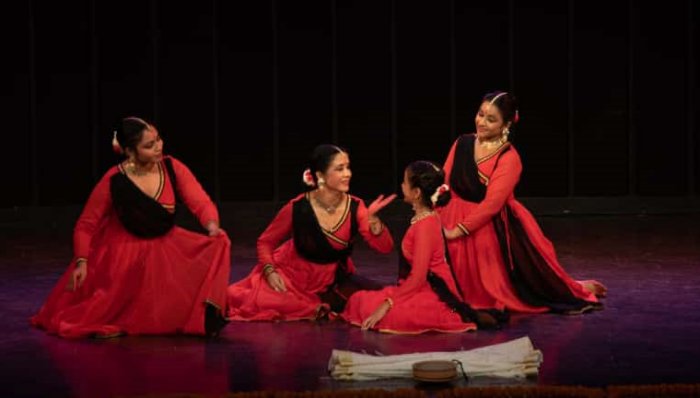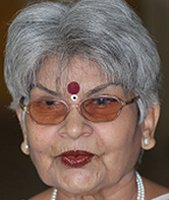
|   |

|   |
Beej: Aahat Aur Anaahat Naad and Anandam - Manjari Sinha e-mail: manjari@sinha.com December 19, 2022 Kathik Cultural Society in association with Ud Imamuddin Khan Dagar Art & Culture Society, the Dagar Archives & Museum, Jaipur, presented 'Beej: Aahat aur Anaahat Naad', at the Stein auditorium of the India Habitat Centre recently. Supported by the Ministry of Culture, this Kathak dance production was conceived and choreographed by dancer Leena Malakar Vij, a senior disciple of Guru Nandini Singh. Leena is also the founder and artistic director of Kathik Cultural Society.  Beej (Photo: Sanjay Kaul) Talking about the theme of 'Beej: Aahat aur Anaahat Naad', Leena stated, "Beej or seed is the soul of this Brahmand. Like the soul, its transition from visible to invisible, from evitable to inevitable, from Atma to Paramatma; this production is about the entire journey of Beej, from where we and nature sprout and how we develop day by day physically, mentally, emotionally and spiritually. It also explores the human layers, its masculine and feminine nature, harmony and conflict, doubt and realization, denial and acceptance." The whole production was based on the script written by the theatre artist Lokesh Jain with vocal and music composed by Shuheb Hasan. Dancers Leena Malakar Vij, Apala Verma, Swarnali Nag, and Ananya Haikuq literally danced to the scripted story interspersed with the technical and abhinaya aspects of Kathak. The script was good, for instance, "Andhere men ankurit hota hai Beej, vichar, srijan, manthan... (it is the darkness from where germinate the seed, ideas, creativity and churning of thoughts, introspection)" and the dramatized voice "sab andhera hai" (there is darkness all over); and dance would go "Dha takit dha" and its variations through the footwork.  Beej (Photo: Sanjay Kaul) The seed grows further and comes out as a little plant and then the flower blooms spreading its fragrance all over. The bees, the birds, the peacock, and the animals are all shown on one hand to depict nature's bounty and on a parallel note the evolving of humans from birth to childhood in playing hide and seek, enjoying the Jhoola on trees, from love and longing of youth to the miseries of old age. If there is the mriga, the deer, and its attractive leaps in nature, then there is also 'mriga-trishna' in humans being attracted to things that are ultimately realized to be meaningless. The thoughtful choreography was interspersed with the tode-tukde, parans and chakkardar tihais to the abhinaya of joy and sorrow according to the scripted story and the music. Light design by Sandeep Dutta was commendable but the problem was that neither the words of the running commentary nor the songs were clearly audible. Leena deserves to be complimented for the concept and choreography but the production needs further work, especially some more input towards the latter half of the title, i.e. 'Aahat aur Anaahat Naad', which felt untouched.  Srishti Debroy (Photo: Sanjit Debroy) 'Anandam' was a delightful evening of Odissi dance by Srishti Debroy presented by Manasija at Triveni Sabhagar, Delhi. A fourth-grade student, Srishti is the talented daughter of Arunima Ghosh, herself a well-known exponent of Odissi dance, a devoted teacher, and the founder of Manasija School of Dance & Music. Anandam echoed Srishti's joy in learning Odissi from the tender age of three and performing for the first time for august audiences that included Odissi gurus like Madhavi Mudgal, Sharon Lowen, Ranjana Gauhar, and her own school Principal. As a tribute to Late Pt. Birju Maharaj, who had promised to bless her on this day, Srishti opened with Mangalacharan joined with the Ganesh Vandana "Gajamukha vadana laage ati sundar..." written and composed by him. The joyful, self-confident demeanor of Srishti regaled the audience from the very beginning, though the raga of this composition was announced as Bhupali and came out to be Yaman! Battu Nritta came next as a perfect synchronization of time, rhythm, and movement which underlined her inherent sense of rhythm. It was the time-tested choreography of Guru Kelucharan Mohapatra with sculpturesque poses from the temple walls of Odisha. The music for this was composed in raga Bhupali by Pt. Bhubaneswar Mishra. Srishti proceeded with Swami Vallabhacharya's Madhurashtakam choreographed by Guru Sharon Lowen and Dashavatara from Jayadeva's Geeta Govinda, before concluding with 'Varsha-Varnan,' a lovely choreography by Arunima Ghosh with lyrics from Valmiki Ramayan in Ragamalika and Talamalika comprising raags like Malhar, Bahar, Megh and taals like Triputa, Jhula, and Ektali. Music was composed by Sukant Nayak and Lavanya Kumar and the rhythmic taal composition by Guru Prafulla Mangaraj. Srishti enjoyed every moment of 'Anandam', evident in her twinkling eyes and smiling face. The melodious orchestra comprised Guru Prafulla Mangaraj on mardal, vocal by Sukant Nayak, sitar by Lavanya Kumar, flute by Dhiraj Pande and manjira by Vishwanath Mangaraj. No doubt Srishti is a gifted child who was born and brought up in the advantageous atmosphere of Odissi at Manasija, and it did show in her amicable involvement with music and dance, but a word of caution for her stance, which needs to be corrected.  Manjari Sinha has an M.A. in Sanskrit and Music, and trained in vocal, tabla, sitar and Kathak dance. She has regular columns in national dailies as a music and dance critic. |